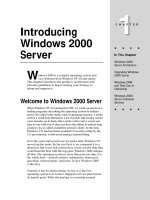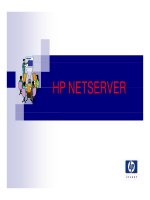Tài liệu Hadoop Real-World Solutions Cookbook doc
Bạn đang xem bản rút gọn của tài liệu. Xem và tải ngay bản đầy đủ của tài liệu tại đây (16.22 MB, 316 trang )
www.it-ebooks.info
Hadoop Real-World
Solutions Cookbook
Realistic, simple code examples to solve problems at
scale with Hadoop and related technologies
Jonathan R. Owens
Jon Lentz
Brian Femiano
BIRMINGHAM - MUMBAI
www.it-ebooks.info
Hadoop Real-World Solutions Cookbook
Copyright © 2013 Packt Publishing
All rights reserved. No part of this book may be reproduced, stored in a retrieval system,
or transmitted in any form or by any means, without the prior written permission of the
publisher, except in the case of brief quotations embedded in critical articles or reviews.
Every effort has been made in the preparation of this book to ensure the accuracy of the
information presented. However, the information contained in this book is sold without
warranty, either express or implied. Neither the authors, nor Packt Publishing, and its
dealers and distributors will be held liable for any damages caused or alleged to be
caused directly or indirectly by this book.
Packt Publishing has endeavored to provide trademark information about all of the
companies and products mentioned in this book by the appropriate use of capitals.
However, Packt Publishing cannot guarantee the accuracy of this information.
First published: February 2013
Production Reference: 1280113
Published by Packt Publishing Ltd.
Livery Place
35 Livery Street
Birmingham B3 2PB, UK.
ISBN 978-1-84951-912-0
www.packtpub.com
Cover Image by iStockPhoto
www.it-ebooks.info
Credits
Authors
Jonathan R. Owens
Jon Lentz
Brian Femiano
Reviewers
Edward J. Cody
Daniel Jue
Bruce C. Miller
Acquisition Editor
Robin de Jongh
Lead Technical Editor
Azharuddin Sheikh
Technical Editor
Dennis John
Copy Editors
Brandt D'Mello
Insiya Morbiwala
Aditya Nair
Alda Paiva
Ruta Waghmare
Project Coordinator
Abhishek Kori
Proofreader
Stephen Silk
Indexer
Monica Ajmera Mehta
Graphics
Conidon Miranda
Layout Coordinator
Conidon Miranda
Cover Work
Conidon Miranda
www.it-ebooks.info
About the Authors
Jonathan R. Owens has a background in Java and C++, and has worked in both private
and public sectors as a software engineer. Most recently, he has been working with Hadoop
and related distributed processing technologies.
Currently, he works for comScore, Inc., a widely regarded digital measurement and analytics
company. At comScore, he is a member of the core processing team, which uses Hadoop
and other custom distributed systems to aggregate, analyze, and manage over 40 billion
transactions per day.
I would like to thank my parents James and Patricia Owens, for their support
and introducing me to technology at a young age.
Jon Lentz is a Software Engineer on the core processing team at comScore, Inc., an online
audience measurement and analytics company. He prefers to do most of his coding in Pig.
Before working at comScore, he developed software to optimize supply chains and allocate
xed-income securities.
To my daughter, Emma, born during the writing of this book. Thanks for the
company on late nights.
www.it-ebooks.info
Brian Femiano has a B.S. in Computer Science and has been programming professionally
for over 6 years, the last two of which have been spent building advanced analytics and Big
Data capabilities using Apache Hadoop. He has worked for the commercial sector in the past,
but the majority of his experience comes from the government contracting space. He currently
works for Potomac Fusion in the DC/Virginia area, where they develop scalable algorithms
to study and enhance some of the most advanced and complex datasets in the government
space. Within Potomac Fusion, he has taught courses and conducted training sessions to
help teach Apache Hadoop and related cloud-scale technologies.
I'd like to thank my co-authors for their patience and hard work building the
code you see in this book. Also, my various colleagues at Potomac Fusion,
whose talent and passion for building cutting-edge capability and promoting
knowledge transfer have inspired me.
www.it-ebooks.info
About the Reviewers
Edward J. Cody is an author, speaker, and industry expert in data warehousing, Oracle
Business Intelligence, and Hyperion EPM implementations. He is the author and co-author
respectively of two books with Packt Publishing, titled The Business Analyst's Guide to Oracle
Hyperion Interactive Reporting 11 and The Oracle Hyperion Interactive Reporting 11 Expert
Guide. He has consulted to both commercial and federal government clients throughout his
career, and is currently managing large-scale EPM, BI, and data warehouse implementations.
I would like to commend the authors of this book for a job well done, and
would like to thank Packt Publishing for the opportunity to assist in the
editing of this publication.
Daniel Jue is a Sr. Software Engineer at Sotera Defense Solutions and a member of the
Apache Software Foundation. He has worked in peace and conict zones to showcase the
hidden dynamics and anomalies in the underlying "Big Data", with clients such as ACSIM,
DARPA, and various federal agencies. Daniel holds a B.S. in Computer Science from the
University of Maryland, College Park, where he also specialized in Physics and Astronomy.
His current interests include merging distributed articial intelligence techniques with
adaptive heterogeneous cloud computing.
I'd like to thank my beautiful wife Wendy, and my twin sons Christopher
and Jonathan, for their love and patience while I research and review. I
owe a great deal to Brian Femiano, Bruce Miller, and Jonathan Larson
for allowing me to be exposed to many great ideas, points of view, and
zealous inspiration.
www.it-ebooks.info
Bruce Miller is a Senior Software Engineer for Sotera Defense Solutions, currently
employed at DARPA, with most of his 10-year career focused on Big Data software
development. His non-work interests include functional programming in languages
like Haskell and Lisp dialects, and their application to real-world problems.
www.it-ebooks.info
www.packtpub.com
Support les, eBooks, discount offers and more
You might want to visit www.packtpub.com for support les and downloads related to
your book.
Did you know that Packt offers eBook versions of every book published, with PDF and ePub
les available? You can upgrade to the eBook version at www.packtpub.com and as a print
book customer, you are entitled to a discount on the eBook copy. Get in touch with us at
for more details.
At www.packtpub.com, you can also read a collection of free technical articles, sign up
for a range of free newsletters and receive exclusive discounts and offers on Packt books
and eBooks.
TM
Do you need instant solutions to your IT questions? PacktLib is Packt's online digital book
library. Here, you can access, read and search across Packt's entire library of books.
Why Subscribe?
f Fully searchable across every book published by Packt
f Copy and paste, print and bookmark content
f On demand and accessible via web browser
Free Access for Packt account holders
If you have an account with Packt at www.packtpub.com, you can use this to access
PacktLib today and view nine entirely free books. Simply use your login credentials for
immediate access.
www.it-ebooks.info
Table of Contents
Preface 1
Chapter 1: Hadoop Distributed File System – Importing
and Exporting Data 7
Introduction 8
Importing and exporting data into HDFS using Hadoop shell commands 8
Moving data efciently between clusters using Distributed Copy 15
Importing data from MySQL into HDFS using Sqoop 16
Exporting data from HDFS into MySQL using Sqoop 21
Conguring Sqoop for Microsoft SQL Server 25
Exporting data from HDFS into MongoDB 26
Importing data from MongoDB into HDFS 30
Exporting data from HDFS into MongoDB using Pig 33
Using HDFS in a Greenplum external table 35
Using Flume to load data into HDFS 37
Chapter 2: HDFS 39
Introduction 39
Reading and writing data to HDFS 40
Compressing data using LZO 42
Reading and writing data to SequenceFiles 46
Using Apache Avro to serialize data 50
Using Apache Thrift to serialize data 54
Using Protocol Buffers to serialize data 58
Setting the replication factor for HDFS 63
Setting the block size for HDFS 64
www.it-ebooks.info
ii
Table of Contents
Chapter 3: Extracting and Transforming Data 65
Introduction 65
Transforming Apache logs into TSV format using MapReduce 66
Using Apache Pig to lter bot trafc from web server logs 69
Using Apache Pig to sort web server log data by timestamp 72
Using Apache Pig to sessionize web server log data 74
Using Python to extend Apache Pig functionality 77
Using MapReduce and secondary sort to calculate page views 78
Using Hive and Python to clean and transform geographical event data 84
Using Python and Hadoop Streaming to perform a time series analytic 89
Using MultipleOutputs in MapReduce to name output les 94
Creating custom Hadoop Writable and InputFormat to read
geographical event data 98
Chapter 4: Performing Common Tasks Using Hive, Pig,
and MapReduce 105
Introduction 105
Using Hive to map an external table over weblog data in HDFS 106
Using Hive to dynamically create tables from the results of a weblog query 108
Using the Hive string UDFs to concatenate elds in weblog data 110
Using Hive to intersect weblog IPs and determine the country 113
Generating n-grams over news archives using MapReduce 115
Using the distributed cache in MapReduce
to nd lines that contain matching keywords over news archives 120
Using Pig to load a table and perform a SELECT operation with GROUP BY 125
Chapter 5: Advanced Joins 127
Introduction 127
Joining data in the Mapper using MapReduce 128
Joining data using Apache Pig replicated join 132
Joining sorted data using Apache Pig merge join 134
Joining skewed data using Apache Pig skewed join 136
Using a map-side join in Apache Hive to analyze geographical events 138
Using optimized full outer joins in Apache Hive to analyze
geographical events 141
Joining data using an external key-value store (Redis) 144
Chapter 6: Big Data Analysis 149
Introduction 149
Counting distinct IPs in weblog data using MapReduce and Combiners 150
Using Hive date UDFs to transform and sort event dates from
geographic event data 156
www.it-ebooks.info
iii
Table of Contents
Using Hive to build a per-month report of fatalities over
geographic event data 159
Implementing a custom UDF in Hive to help validate source reliability
over geographic event data 161
Marking the longest period of non-violence using Hive
MAP/REDUCE operators and Python 165
Calculating the cosine similarity of artists in the Audioscrobbler
dataset using Pig 171
Trim Outliers from the Audioscrobbler dataset using Pig and datafu 174
Chapter 7: Advanced Big Data Analysis 177
Introduction 177
PageRank with Apache Giraph 178
Single-source shortest-path with Apache Giraph 180
Using Apache Giraph to perform a distributed breadth-rst search 192
Collaborative ltering with Apache Mahout 200
Clustering with Apache Mahout 203
Sentiment classication with Apache Mahout 206
Chapter 8: Debugging 209
Introduction 209
Using Counters in a MapReduce job to track bad records 210
Developing and testing MapReduce jobs with MRUnit 212
Developing and testing MapReduce jobs running in local mode 215
Enabling MapReduce jobs to skip bad records 217
Using Counters in a streaming job 220
Updating task status messages to display debugging information 222
Using illustrate to debug Pig jobs 224
Chapter 9: System Administration 227
Introduction 227
Starting Hadoop in pseudo-distributed mode 227
Starting Hadoop in distributed mode 231
Adding new nodes to an existing cluster 234
Safely decommissioning nodes 236
Recovering from a NameNode failure 237
Monitoring cluster health using Ganglia 239
Tuning MapReduce job parameters 241
Chapter 10: Persistence Using Apache Accumulo 245
Introduction 245
Designing a row key to store geographic events in Accumulo 246
Using MapReduce to bulk import geographic event data into Accumulo 256
www.it-ebooks.info
iv
Table of Contents
Setting a custom eld constraint for inputting geographic event
data in Accumulo 264
Limiting query results using the regex ltering iterator 270
Counting fatalities for different versions of the same key
using SumCombiner 273
Enforcing cell-level security on scans using Accumulo 278
Aggregating sources in Accumulo using MapReduce 283
Index 289
www.it-ebooks.info
Preface
Hadoop Real-World Solutions Cookbook helps developers become more comfortable with,
and procient at solving problems in, the Hadoop space. Readers will become more familiar
with a wide variety of Hadoop-related tools and best practices for implementation.
This book will teach readers how to build solutions using tools such as Apache Hive, Pig,
MapReduce, Mahout, Giraph, HDFS, Accumulo, Redis, and Ganglia.
This book provides in-depth explanations and code examples. Each chapter contains a set
of recipes that pose, and then solve, technical challenges and that can be completed in
any order. A recipe breaks a single problem down into discrete steps that are easy to follow.
This book covers unloading/loading to and from HDFS, graph analytics with Giraph, batch
data analysis using Hive, Pig, and MapReduce, machine-learning approaches with Mahout,
debugging and troubleshooting MapReduce jobs, and columnar storage and retrieval of
structured data using Apache Accumulo.
This book will give readers the examples they need to apply the Hadoop technology to their
own problems.
What this book covers
Chapter 1, Hadoop Distributed File System – Importing and Exporting Data, shows several
approaches for loading and unloading data from several popular databases that include
MySQL, MongoDB, Greenplum, and MS SQL Server, among others, with the aid of tools
such as Pig, Flume, and Sqoop.
Chapter 2, HDFS, includes recipes for reading and writing data to/from HDFS. It shows
how to use different serialization libraries, including Avro, Thrift, and Protocol Buffers.
Also covered is how to set the block size and replication, and enable LZO compression.
Chapter 3, Extracting and Transforming Data, includes recipes that show basic Hadoop
ETL over several different types of data sources. Different tools, including Hive, Pig, and
the Java MapReduce API, are used to batch-process data samples and produce one or
more transformed outputs.
www.it-ebooks.info
Preface
2
Chapter 4, Performing Common Tasks Using Hive, Pig, and MapReduce, focuses on how
to leverage certain functionality in these tools to quickly tackle many different classes of
problems. This includes string concatenation, external table mapping, simple table joins,
custom functions, and dependency distribution across the cluster.
Chapter 5, Advanced Joins, contains recipes that demonstrate more complex and useful
join techniques in MapReduce, Hive, and Pig. These recipes show merged, replicated, and
skewed joins in Pig as well as Hive map-side and full outer joins. There is also a recipe that
shows how to use Redis to join data from an external data store.
Chapter 6, Big Data Analysis, contains recipes designed to show how you can put Hadoop
to use to answer different questions about your data. Several of the Hive examples will
demonstrate how to properly implement and use a custom function (UDF) for reuse
in different analytics. There are two Pig recipes that show different analytics with the
Audioscrobbler dataset and one MapReduce Java API recipe that shows Combiners.
Chapter 7, Advanced Big Data Analysis, shows recipes in Apache Giraph and Mahout
that tackle different types of graph analytics and machine-learning challenges.
Chapter 8, Debugging, includes recipes designed to aid in the troubleshooting and testing
of MapReduce jobs. There are examples that use MRUnit and local mode for ease of testing.
There are also recipes that emphasize the importance of using counters and updating task
status to help monitor the MapReduce job.
Chapter 9, System Administration, focuses mainly on how to performance-tune and optimize
the different settings available in Hadoop. Several different topics are covered, including basic
setup, XML conguration tuning, troubleshooting bad data nodes, handling NameNode failure,
and performance monitoring using Ganglia.
Chapter 10, Persistence Using Apache Accumulo, contains recipes that show off many of
the unique features and capabilities that come with using the NoSQL datastore Apache
Accumulo. The recipes leverage many of its unique features, including iterators, combiners,
scan authorizations, and constraints. There are also examples for building an efcient
geospatial row key and performing batch analysis using MapReduce.
What you need for this book
Readers will need access to a pseudo-distributed (single machine) or fully-distributed
(multi-machine) cluster to execute the code in this book. The various tools that the recipes
leverage need to be installed and properly congured on the cluster. Moreover, the code
recipes throughout this book are written in different languages; therefore, it’s best if
readers have access to a machine with development tools they are comfortable using.
www.it-ebooks.info
Preface
3
Who this book is for
This book uses concise code examples to highlight different types of real-world problems you
can solve with Hadoop. It is designed for developers with varying levels of comfort using Hadoop
and related tools. Hadoop beginners can use the recipes to accelerate the learning curve and
see real-world examples of Hadoop application. For more experienced Hadoop developers,
many of the tools and techniques might expose them to new ways of thinking or help clarify a
framework they had heard of but the value of which they had not really understood.
Conventions
In this book, you will nd a number of styles of text that distinguish between different kinds
of information. Here are some examples of these styles, and an explanation of their meaning.
Code words in text are shown as follows: “All of the Hadoop lesystem shell commands take
the general form hadoop fs –COMMAND.”
A block of code is set as follows:
weblogs = load ‘/data/weblogs/weblog_entries.txt’ as
(md5:chararray,
url:chararray,
date:chararray,
time:chararray,
ip:chararray);
md5_grp = group weblogs by md5 parallel 4;
store md5_grp into ‘/data/weblogs/weblogs_md5_groups.bcp’;
When we wish to draw your attention to a particular part of a code block, the relevant lines or
items are set in bold:
weblogs = load ‘/data/weblogs/weblog_entries.txt’ as
(md5:chararray,
url:chararray,
date:chararray,
time:chararray,
ip:chararray);
md5_grp = group weblogs by md5 parallel 4;
store md5_grp into ‘/data/weblogs/weblogs_md5_groups.bcp’;
www.it-ebooks.info
Preface
4
Any command-line input or output is written as follows:
hadoop distcp –m 10 hdfs://namenodeA/data/weblogs hdfs://namenodeB/data/
weblogs
New terms and important words are shown in bold. Words that you see on the screen, in
menus or dialog boxes for example, appear in the text like this: “To build the JAR le, download
the Jython java installer, run the installer, and select Standalone from the installation menu”.
Warnings or important notes appear in a box like this.
Tips and tricks appear like this.
Reader feedback
Feedback from our readers is always welcome. Let us know what you think about this
book—what you liked or may have disliked. Reader feedback is important for us to develop
titles that you really get the most out of.
To send us general feedback, simply send an e-mail to , and
mention the book title via the subject of your message.
If there is a topic that you have expertise in and you are interested in either writing or
contributing to a book, see our author guide on www.packtpub.com/authors.
Customer support
Now that you are the proud owner of a Packt book, we have a number of things to help you
to get the most from your purchase.
Downloading the example code
You can download the example code les for all Packt books you have purchased from
your account at . If you purchased this book elsewhere,
you can visit and register to have the les
e-mailed directly to you.
www.it-ebooks.info
Preface
5
Errata
Although we have taken every care to ensure the accuracy of our content, mistakes do happen.
If you nd a mistake in one of our books—maybe a mistake in the text or the code—we would be
grateful if you would report this to us. By doing so, you can save other readers from frustration
and help us improve subsequent versions of this book. If you nd any errata, please report them
by visiting selecting your book, clicking on the errata
submission form link, and entering the details of your errata. Once your errata are veried, your
submission will be accepted and the errata will be uploaded on our website, or added to any
list of existing errata, under the Errata section of that title. Any existing errata can be viewed
by selecting your title from />Piracy
Piracy of copyright material on the Internet is an ongoing problem across all media. At Packt,
we take the protection of our copyright and licenses very seriously. If you come across any
illegal copies of our works, in any form, on the Internet, please provide us with the location
address or website name immediately so that we can pursue a remedy.
Please contact us at with a link to the suspected
pirated material.
We appreciate your help in protecting our authors, and our ability to bring you
valuable content.
Questions
You can contact us at if you are having a problem with
any aspect of the book, and we will do our best to address it.
www.it-ebooks.info
www.it-ebooks.info
1
Hadoop Distributed File
System – Importing and
Exporting Data
In this chapter we will cover:
f Importing and exporting data into HDFS using the Hadoop shell commands
f Moving data efciently between clusters using Distributed Copy
f Importing data from MySQL into HDFS using Sqoop
f Exporting data from HDFS into MySQL using Sqoop
f Conguring Sqoop for Microsoft SQL Server
f Exporting data from HDFS into MongoDB
f Importing data from MongoDB into HDFS
f Exporting data from HDFS into MongoDB using Pig
f Using HDFS in a Greenplum external table
f Using Flume to load data into HDFS
www.it-ebooks.info
Hadoop Distributed File System – Importing and Exporting Data
8
Introduction
In a typical installation, Hadoop is the heart of a complex ow of data. Data is often collected
from many disparate systems. This data is then imported into the Hadoop Distributed File
System (HDFS). Next, some form of processing takes place using MapReduce or one of the
several languages built on top of MapReduce (Hive, Pig, Cascading, and so on). Finally, the
ltered, transformed, and aggregated results are exported to one or more external systems.
For a more concrete example, a large website may want to produce basic analytical data
about its hits. Weblog data from several servers is collected and pushed into HDFS. A
MapReduce job is started, which runs using the weblogs as its input. The weblog data
is parsed, summarized, and combined with the IP address geolocation data. The output
produced shows the URL, page views, and location data by each cookie. This report is
exported into a relational database. Ad hoc queries can now be run against this data.
Analysts can quickly produce reports of total unique cookies present, pages with the
most views, breakdowns of visitors by region, or any other rollup of this data.
The recipes in this chapter will focus on the process of importing and exporting data to and
from HDFS. The sources and destinations include the local lesystem, relational databases,
NoSQL databases, distributed databases, and other Hadoop clusters.
Importing and exporting data into HDFS
using Hadoop shell commands
HDFS provides shell command access to much of its functionality. These commands are
built on top of the HDFS FileSystem API. Hadoop comes with a shell script that drives all
interaction from the command line. This shell script is named hadoop and is usually located
in $HADOOP_BIN, where $HADOOP_BIN is the full path to the Hadoop binary folder. For
convenience, $HADOOP_BIN should be set in your $PATH environment variable. All of the
Hadoop lesystem shell commands take the general form hadoop fs -COMMAND.
To get a full listing of the lesystem commands, run the hadoop shell script passing it the fs
option with no commands.
hadoop fs
www.it-ebooks.info
Chapter 1
9
These command names along with their functionality closely resemble Unix shell commands.
To get more information about a particular command, use the help option.
hadoop fs –help ls
The shell commands and brief descriptions can also be found online in the ofcial
documentation located at />shell.html
In this recipe, we will be using Hadoop shell commands to import data into HDFS and export
data from HDFS. These commands are often used to load ad hoc data, download processed
data, maintain the lesystem, and view the contents of folders. Knowing these commands is
a requirement for efciently working with HDFS.
www.it-ebooks.info
Hadoop Distributed File System – Importing and Exporting Data
10
Getting ready
You will need to download the weblog_entries.txt dataset from the Packt website
/>How to do it
Complete the following steps to create a new folder in HDFS and copy the weblog_entries.
txt le from the local lesystem to HDFS:
1. Create a new folder in HDFS to store the weblog_entries.txt le:
hadoop fs –mkdir /data/weblogs
2. Copy the weblog_entries.txt le from the local lesystem into the new folder
created in HDFS:
hadoop fs –copyFromLocal weblog_entries.txt /data/weblogs
3. List the information in the weblog_entires.txt le:
hadoop fs –ls /data/weblogs/weblog_entries.txt
The result of a job run in Hadoop may be used by an external system,
may require further processing in a legacy system, or the processing
requirements might not fit the MapReduce paradigm. Any one of these
situations will require data to be exported from HDFS. One of the simplest
ways to download data from HDFS is to use the Hadoop shell.
4. The following code will copy the weblog_entries.txt le from HDFS to the local
lesystem's current folder:
hadoop fs –copyToLocal /data/weblogs/weblog_entries.txt ./weblog_
entries.txt
www.it-ebooks.info
Chapter 1
11
When copying a le from HDFS to the local lesystem, keep in mind the space available on
the local lesystem and the network connection speed. It's not uncommon for HDFS to have
le sizes in the range of terabytes or even tens of terabytes. In the best case scenario, a ten
terabyte le would take almost 23 hours to be copied from HDFS to the local lesystem over
a 1-gigabit connection, and that is if the space is available!
Downloading the example code for this book
You can download the example code les for all the Packt books you have
purchased from your account at . If you
purchased this book elsewhere, you can visit ktpub.
com/support and register to have the les e-mailed directly to you.
How it works
The Hadoop shell commands are a convenient wrapper around the HDFS FileSystem API.
In fact, calling the hadoop shell script and passing it the fs option sets the Java application
entry point to the org.apache.hadoop.fs.FsShell class. The FsShell class then
instantiates an org.apache.hadoop.fs.FileSystem object and maps the lesystem's
methods to the fs command-line arguments. For example, hadoop fs –mkdir /data/
weblogs, is equivalent to FileSystem.mkdirs(new Path("/data/weblogs")).
Similarly, hadoop fs –copyFromLocal weblog_entries.txt /data/weblogs is
equivalent to FileSystem.copyFromLocal(new Path("weblog_entries.txt"),
new Path("/data/weblogs")). The same applies to copying the data from HDFS to the
local lesystem. The copyToLocal Hadoop shell command is equivalent to FileSystem.
copyToLocal(new Path("/data/weblogs/weblog_entries.txt"), new
Path("./weblog_entries.txt")). More information about the FileSystem class
and its methods can be found on its ofcial Javadoc page: />docs/r0.20.2/api/org/apache/hadoop/fs/FileSystem.html.
The mkdir command takes the general form of hadoop fs –mkdir PATH1 PATH2.
For example, hadoop fs –mkdir /data/weblogs/12012012 /data/
weblogs/12022012 would create two folders in HDFS: /data/weblogs/12012012
and /data/weblogs/12022012, respectively. The mkdir command returns 0 on
success and -1 on error:
hadoop fs –mkdir /data/weblogs/12012012 /data/weblogs/12022012
hadoop fs –ls /data/weblogs
www.it-ebooks.info
Hadoop Distributed File System – Importing and Exporting Data
12
The copyFromLocal command takes the general form of hadoop fs –copyFromLocal
LOCAL_FILE_PATH URI. If the URI is not explicitly given, a default is used. The default
value is set using the fs.default.name property from the core-site.xml le.
copyFromLocal returns 0 on success and -1 on error.
The copyToLocal command takes the general form of hadoop fs –copyToLocal
[-ignorecrc] [-crc] URI LOCAL_FILE_PATH. If the URI is not explicitly given, a default
is used. The default value is set using the fs.default.name property from the core-site.
xml le. The copyToLocal command does a Cyclic Redundancy Check (CRC) to verify that
the data copied was unchanged. A failed copy can be forced using the optional –ignorecrc
argument. The le and its CRC can be copied using the optional –crc argument.
There's more
The command put is similar to copyFromLocal. Although put is slightly more general,
it is able to copy multiple les into HDFS, and also can read input from stdin.
The get Hadoop shell command can be used in place of the copyToLocal command.
At this time they share the same implementation.
When working with large datasets, the output of a job will be partitioned into one or more
parts. The number of parts is determined by the mapred.reduce.tasks property which
can be set using the setNumReduceTasks() method on the JobConf class. There will
be one part le for each reducer task. The number of reducers that should be used varies
from job to job; therefore, this property should be set at the job and not the cluster level.
The default value is 1. This means that the output from all map tasks will be sent to a single
reducer. Unless the cumulative output from the map tasks is relatively small, less than a
gigabyte, the default value should not be used. Setting the optimal number of reduce tasks
can be more of an art than science. In the JobConf documentation it is recommended that
one of the two formulae be used:
0.95 * NUMBER_OF_NODES * mapred.tasktracker.reduce.tasks.maximum
Or
1.75 * NUMBER_OF_NODES * mapred.tasktracker.reduce.tasks.maximum
For example, if your cluster has 10 nodes running a task tracker and the mapred.
tasktracker.reduce.tasks.maximum property is set to have a maximum of ve reduce
slots, the formula would look like this 0.95 * 10 * 5 = 47.5. Since the number of reduce slots
must be a nonnegative integer, this value should be rounded or trimmed.
www.it-ebooks.info









